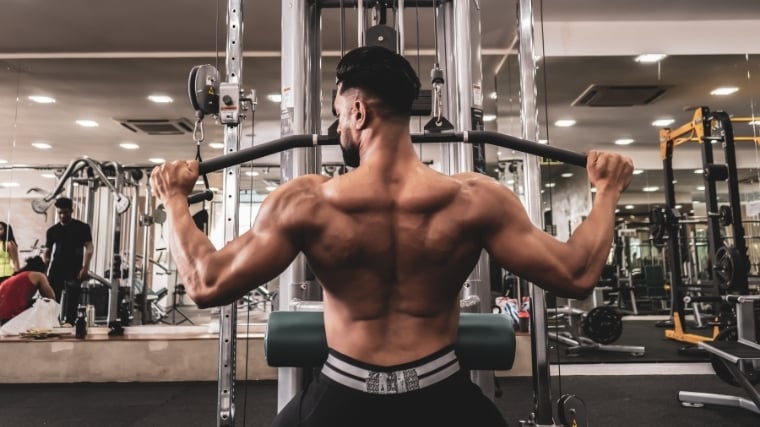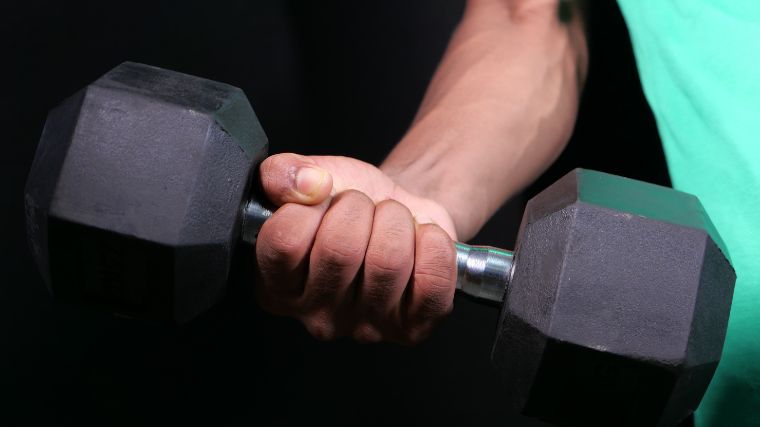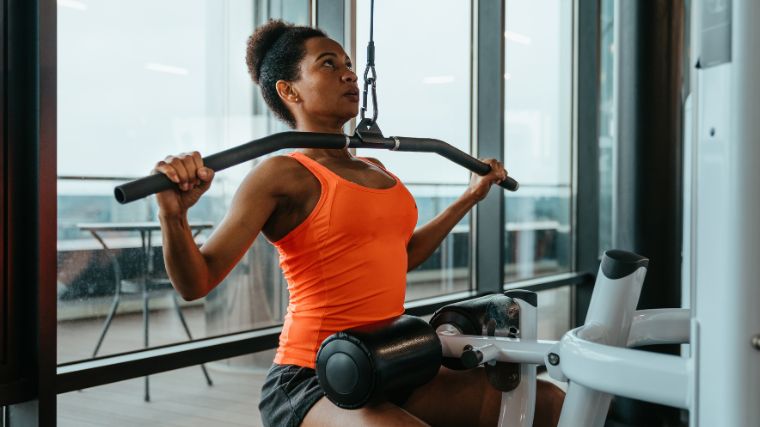Big lats serve two primary purposes: They support your spine during squats, deadlifts, and bench presses and make you look big in sweaters. However, many lifters have trouble engaging their lats because we don’t use them much in daily activities — it requires a conscious effort. The lower lats specifically often lack strength and development, mainly because many people cut the range of motion of their upper-body pulling movements short, leaving gains on the table.

Below are five of the best lower lat exercises for overall back development, strength, and aesthetics. Besides outlining tried-and-true movements like lat pulldowns, we also provide more advanced variations to try, like underhanded bent over rows.
5 Best Lower Lat Exercises
- Wide Grip Lat Pulldown
- Dumbbell Row To Hips
- Seated Banded Row
- Straight Arm Pulldown
- Underhanded Bent Over Row
Editor’s Note: The content on BarBend is meant to be informative in nature, but it shouldn’t take the place of advice and/or supervision from a medical professional. The opinions and articles on this site are not intended for use as diagnosis, prevention, and/or treatment of health problems. Speak with your physician if you have any concerns.
1. Wide Grip Lat Pulldown
The wide grip lat pulldown focuses on the outer and lower part of the lats more than the traditional close-grip version. The wider grip variation reduces the work of the biceps and forearms as there is less elbow flexio, which therefore requires more of your lats to pull the weight down. Also, the wide grip allows you to alter your arm angle so that your elbows are pulled from high and out to close and in, which will elicit a contraction from your low lats.
[Read More: Build a Titanic Torso with These Bodybuilding Chest & Back Workouts]
The reduced workload on the biceps and forearms means increased muscular tension on then lats for bigger strength and hypertrophy gains. The wide-grip lat pulldown is also specifically designed to improve your shoulder-to-waist ratio for bodybuilding aesthetics.
How to Do It
- Face the lat pulldown machine and snuggly fit the thighs underneath the pad.
- Take a wide overhand grip of the bar, grip tight and slightly lean your torso back and take a deep breath in.
- Pull the bar towards the nipple line of your chest while keeping your core tight and exhale.
- Pause for a second and slowly return to the starting position, and repeat.
Coach’s Tip: You don’t need to grip the handles too wide; doing so may compromise your ability to generate force.
Sets and Reps: Try 3 to 4 sets of 12 to 15 repetitions.
2. Dumbbell Row to Hips
Single-arm rows are great at ironing out strength imbalances between sides and are a great upper back builder. But with a little tweak, it’s a great lower lat builder. When you start the exercise, instead of rowing up, think about pulling back — as this will result in an arc-like range of motion, where the weight starts below your shoulder and finishes at your hip. This helps you really feel the lower lats contract and work.
[Read More: The Best Back Workout for Men, Women, Strength, and More]
The larger range of motion here puts more muscular tension on the lower lats, while rowing towards the hips reduces the common technique flaw of shrugging the upper traps while doing single-arm rows. What’s more and just like any other single-arm row, working one side of your body at a time should help prevent or address unilateral imbalances.
How to Do It
- Support your non-working hand on a bench or dumbbell rack and take a big step back with the opposite leg.
- With a firm grip of the dumbbell on the inside of your front foot, row the dumbbell to the outside of your hip while keeping your shoulders down and chest up.
- Pause for a second and slowly lower down to the starting position and repeat for reps.
Coach’s Tip: Think about putting your elbow into your back pocket during this exercise.
Sets and Reps: Go for 4 sets of 8 to 12 repetitions.
3. Seated Band Row
Performing seated rows with bands help place the lats under constant tension and to place your body in an ideal position without restrictions (think bar path) that dumbbells and barbells might lock you into. The key with seated band rows is keeping your shoulders externally rotated, and with slight scapular depression, and to focus on using your lats and not your traps.
[Read More: 5 At-Home Workouts for Strength, Muscle Growth, Power, and More]
Banded back exercises are convenient and easy to perform just about anywhere, so you can use an exercise like the seated band row as a primer before your workout or even as an intra-set intensity technique. The constant, mounting tension of the band should also feel quite comfortable on your joints, making this move a suitable option if you want to train your back without overloading your connective tissues too much.
How to Do It
- Sit down on the floor with your legs extended.
- Loop a resistance band around the middle of your feet, holding an end in each hand.
- Keep your back straight, fully extend your arms, and then row your elbows until they pass your torso.
Coach’s Tip: To better target the lower lats, keep your elbows tucked in at your sides.
Sets and Reps: Try 2 or 3 rounds of 15 to 20 repetitions on this one.
4. Straight Arm Lat Pulldown
This exercise can be performed with either a cable machine or a resistance band, but the premise is the same. You’ll grab either implement with your arms straight (as the name imples), and then flex your lats to pull your arms down to your sides. The straight-arm lat pulldown is a great exercise if you have trouble ’feeling’ your lats during any pulling movement and is a great deadlift accessory exercise too.
[Read More: What Are Workout Splits and Which Is the Best One?]
If you have trouble feeling your lats, the straight-arm pulldown will almost certainly cure you of this problem, since it places constant tension on the lats due to minimal involvement of the biceps. It’s also quite joint friendly and most folks find they can do it comfortably in the absence of a row movement.
How to Do It
- Choose your equipment (bands or cable machine) and attachment of choice, either straight bar, handles, or rope.
- Grip the attachment, take a step back and lean your torso forward slightly, keeping your hand above shoulder height.
- Pull, keeping your arms straight until you reach your hips and pause for a second. Slowly return to the starting position and repeat.
Coach’s Tip: Resist the weight on the eccentric until your arm raises up parallel with your torso.
Sets and Reps: Try out 2 to 3 sets of 12 to 15 repetitions on this one.
5. Underhanded Bent Over Row
Most pulling exercises train the lats to a certain degre. To better target the lower lats, you need a little tweak in the technique here or there to focus on them. For example, the switch in hand position to underhanded for the bent over row trains more scapular depression, which helps train the lower lats. Plus, it focuses more on the biceps too. Like you needed an excuse.
[Read More: Get Freakishly Strong With the 5×5 Workout Program]
The underhanded bent-over row adds strength and mass to your upper back, lower lats, biceps, and erector spinae. It also reinforces good hip hinge mechanics, which will have a direct carryover to your deadlift.
How to Do It
- Hinge at your hips and grab a loaded barbell with an underhanded grip that’s slightly wider than shoulder-width.
- Squeeze your shoulder blades together and row the barbell until it’s touching your stomach.
- Hold the top position of the row for a beat and then slowly lower the weight back down.
Coach’s Tip: Externally rotate your shoulders by keeping the insides of your upper arms tucked tightly against your torso as you row.
Sets and Reps: Hit 3 to 4 sets of 5 to 8 repetitions on this exercise.
Lower Lat Warm-Up
The lats are a larger muscle and require blood flow and activation before any upper or lower body training. Lats are often sore or stretched due to sitting with rounded shoulders or standing with military posture. Both will affect the mobility of the shoulder joint.
Foam rolling the upper and lower back drives blood flow to this area to reduce soreness, stiffness, and helps to improve mobility. Doing 10-15 slow rolls over this area, stopping, and concentrating on sore spots is a great way to warm up this area.
[Read More: The 7 Best Foam Roller Exercises for Mobility and Better Movement]
For activation purposes, performing light work sets of 12-15 reps of the five exercises listed works well. Or, you can add in two sets of six reps of the dead bug with pullover, which is a great move to activate your lats and tax your core muscles.
How To Train Your Lower Lats
As one of the largest muscle in the upper body, your lats are involved in lots of upper-body movements. These movements include vertical pulls, horizontal pulls, and isolation moves that involve shoulder extension. With so many movement options available, how you opt to train your lats matters a great deal.
Lower Lat Exercise Selection
To target your lower lats, you shouldn’t limit yourself to any one type of movement such as only vertical pulls or only bent-over rows. Developing a specific section of a muscle (think of your inner chest or your biceps peak) is certainly possible, but only if you’re willing to experiment and tolerate some trial and error.

[Read More: The Best Full-Body Bodybuilding Workout for Beginner to Advanced Lifters]
Generally speaking, you may find success by emphasizing movements that involve both shoulder retraction and extension; moves that require you to bring your elbow both down and back.
Lower Lat Sets and Reps
When trying to develop a specific region of a muscle, you have to consider the fact that other tissues may take over and steal some of the limelight. For instance, if you have very strong arms, they may interfere with your efforts to target your lower lats.
As such, you may have success with higher rep ranges that induce more fatigue. Don’t be afraid to break into the 12, 15, or even 20-rep range if you’re trying to bring up your lower lats.
Lower Lat Training Tips
Addressing bodybuilding weak points takes more than sheer effort. You need a smart approach, a steady hand, and heaps of patience to boot. These training tips should help you get a bit more juice out of your back workouts if you want to target your lower lats.
Don’t Be Shy About Straps
A strong grip is integral to performing well as a strength athlete. But if you’re in the gym trying to bring up your lower lats specifically, you probably aren’t signing up for a powerlifting meet or strongman competition anytime soon. As such, you shouldn’t get too wrapped up in preserving maximal grip strength, especially if it interferes with the quality of your back exercises.

[Read More: The 8 Best Lifting Straps You Can Buy]
Relying heavily on straps takes your grip and forearm strength out of the equation entirely. This ensures that grip doesn’t limit your loading potential, and should also free up some mental real estate to find a better mind-muscle connection with your back.
Find the Feeling
A strong mind-muscle connection isn’t essential to create muscle growth, but “finding the feeling” may help you develop your lower lats. Some data has shown a correlation between that connection and hypertrophic potential. (1) At worst, tweaking your technique will help you understand your own body a bit better.
Benefits of Training Your Lats
Your lats are the largest and, debatably, most powerful muscles in your upper body. You may not be able to see them in the mirror, but you should absolutely make them a training priority when you’re in the gym.
Aesthetics
Visually, the V-shaped torso and broad shoulders are desired by almost all lifters who grace the gym. And to get this look, you need to train the lats hard and heavy combined with a good diet for a smaller waistline. Well-developed, muscular lats improve your shoulder-to-waist ratio and create the illusion of a smaller waist as well.
Strength Performance
The lats play a vital role in the big three (the bench press, squat, and deadlift), even if they are not trained directly. While squatting, the lats are engaged (by pulling the barbell down into your upper back) and keeps you in an upright posture, so your squat does not turn into a good morning.
For deadlifts, strong and engaged lats keep you in a neutral spine while in the hinge position and keep the bar close to you as you pull. The further the bar is away from during the pull the more prone to rounding your spine you are.

During the bench press, engaged lats provide a stable base to press from and assist in an efficient pressing path. Plus, the lats play a role in transferring force from your leg drive to your chest.
What Muscles Make Up the Lats?
Colloquially, the “lats” refer to your latissimus dorsi muscles; two large, fan-shaped tissues that span the length of the back of your torso. With so much area to cover, your lower lats are both visually and functionally distinct.
Your lats originate along the thoracolumbar fascia and pelvis and make their way up your back, connecting to various points on your humerus bone in your upper arm. While your lower lats may not be a completely unique muscle, they’re geographically so far from the upper sections of the tissue that you can likely focus on them directly during your workouts.
More Training Content
- 7 Barbell Back Exercises That Are Not the Deadlift
- The 6 Best Lower Back Exercises for Stability and Strength
- Do Different Row Grips Really Matter?
References
- Schoenfeld, B. J., Vigotsky, A., Contreras, B., Golden, S., Alto, A., Larson, R., Winkelman, N., & Paoli, A. (2018). Differential effects of attentional focus strategies during long-term resistance training. European journal of sport science, 18(5), 705–712.
Featured Image: martvisionlk / Shutterstock
The post The 5 Best Lower Lat Exercises for a Denser Back appeared first on BarBend.
